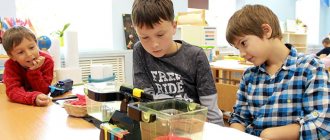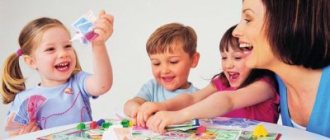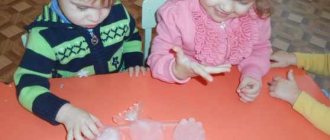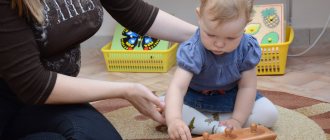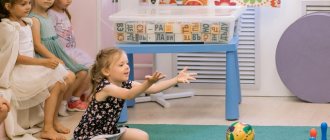In order to raise a harmoniously developed personality, it is advisable not to waste a minute, starting from a very tender age. The formation of personality begins immediately after birth, and how exactly the parents behave at this time will subsequently influence what kind of person the newborn will be. There are many techniques that can be used in the early stages. One of the most popular is the early development method of Maria Montessori, because it can be implemented without any problems without having a special education or the ability to pay for the services of professionals.
Montessori system: methods principles
Principle No. 1. Guide the child’s self-development. To do this, it is necessary to organize special conditions. In them he himself will look for answers to questions. The teacher’s task is to reveal the child’s potential.
Principle No. 2. Individual approach. Each child - in a kindergarten, school or family group - is treated individually. They take into account his personal characteristics, temperament, abilities, interests.
Principle No. 3. Recognize the uniqueness of the child. It was given to him from birth. And by nature, a child has a desire to work, develop, and improve himself. The main thing is to push him.
Principle No. 4. Unleash potential, not “sculpt” character. Parents and teachers are “guides”, not an unshakable authority. They do not teach and educate, but guide children and encourage them to act independently.
Principle #5 : Learning through discovery. The children learn new things and master skills through working with didactic material and toys. Learning by doing, not by what the teacher tells you.
Some parents confuse the principle of non-interference with passivity. It is not right. Montessori education requires special training. But parents can implement it at home too.
Algorithmization
Working with practical life exercises algorithmizes children's activities, laying the foundations of mathematical thinking. When a teacher shows a presentation, he always performs actions in a certain sequence. For example, when pouring water from a jug into a glass, an adult first:
- will bring a tray with materials to the table;
- spread the protector;
- will put a jug and a glass on him;
- will bring water from the main jug;
- pour it into a pitcher for presentation;
- then he will return the main jug to its place and so on.
The simplest presentation already has a fairly long list of sequential steps. The skills of performing actions in this way will later be useful when working with mathematical material.
UPZ algorithms are built from simple to complex, which helps children achieve difficult intellectual activities gradually and smoothly.
Montessori environment for children's development
The Montessori education system will be effective if a number of rules are followed. One of them is the organization of space for classes. It should be spacious, bright, cozy and quiet. Furniture should correspond to the height of children - for free access to materials and toys.
An important role is played by the zoning of the premises - there are 5 zones:
- Sensory. Here they develop their sense of smell, touch, hearing and vision. Children learn to distinguish and combine objects according to different characteristics;
- Mathematical. Here they develop logical thinking and learn how to perform mathematical operations. The children master the concept of quantity and its connection with symbols;
- Language. Here the children learn to read and write;
- "Space". Natural phenomena, the surrounding world, culture, history - the children will learn about all this in this zone;
- Practical. Here children learn self-service and self-care skills.
The guys decide for themselves which zone they want to be in at the moment. The duration of classes, the material, the pace of learning - they choose it all themselves. The adult’s task is to stimulate interest in the lesson and guide the student.
Wooden children's toys according to the Montessori system
In 90% of the class time, children learn from materials - educational toys, household items. Their difference from other toys is natural materials: wood, fur, fabrics of different textures.
Laces, fasteners, insert frames, cubes, pyramids, magnetic fishing, musical instruments, puzzles, sorters, boards with cylinders, games for training fine motor skills - the variety of wooden children's toys according to the Montessori system is enormous. They are arranged according to the thematic zone.
Benefits play an important role - learning takes place in the form of a game. This is the leading type of activity for the guys, they are interested - the effectiveness of the classes increases.
Freedom of choice and formation of will
The possibility of intelligent choice, presented in the zone of practical life, develops the will. The external manifestation of will is freedom of choice and control over one’s movements. If a preschooler has these two properties, then we can talk about the development of his will.
Another indicator is perseverance, which is formed when performing exercises from the educational program. For example, at the initial stage of sewing on cardboard, the child does not always get the needle into the holes, but every time he strains his muscles to control his hand with the needle, the preschooler achieves a positive result - the movements become precise, and the thread lays on the cardboard in beautiful, even stitches.
Benefits of the Montessori method for children
Early development has many benefits. Let's list them:
- the boys learn responsibility. In the future, they themselves identify and correct errors;
- kids are independent. From an early age they learn self-service skills - dressing, washing, brushing teeth, cleaning up after themselves;
- organize their time - leisure, study, play themselves. In the future, time is controlled;
- successfully socialize - adapt to any team, accept and follow the rules. Adopt and pass on the experience gained, help others;
- develop initiative - strive to learn, are interested in new things, ask questions, look for answers and solutions.
The goal of Maria Montessori's education system is the formation of a free, holistic personality. A free person knows his own boundaries and respects the boundaries of other people.
Rules of communication using the Montessori method for children
They will be useful to children in adulthood.
- Don't disturb if the person is busy;
- Help the younger one;
- Consider the interests of others when choosing an area to play or study;
- Be quiet - don't disturb other guys;
- Take away your toys and manuals, wipe the surface after modeling or drawing;
- The toy is busy - wait your turn.
Matching games
Matching games are the most popular Montessori activities for ages 1 to 3. The main types are:
- Activities with colors - you can offer your child a cardboard circle with multi-colored sectors and clothespins of the same shades. The child must independently choose his own clothespin for each sector.
- The game can be combined with the help of mom. For example, invite your child to sort washed socks into pairs.
Training and education of children with mental retardation using a correction program
This group of classes develops logic and attention.
Games with colors
Sensitive periods in the Montessori education system
Sensitivity is sensitivity, receptivity. At each age period, the child is susceptible to a certain type of activity. The timing and duration of the sensitive period is different for everyone, age also varies - children develop differently. Psychologists advise parents to focus on their own child.
In the Montessori method for children, sensitive periods play an important role.
From birth to 6 years: speech development
At the age of up to 12 months, children are passionate about speech and communication with their parents. This happens through onomatopoeia, the emotional sphere. Kids crave interaction with adults. Speech is not available to them - emotional contact with loved ones comes to the fore. A lack of attention and communication will lead to disruption of the further full development of the child.
From 1 to 3 years is the period of mastering oral speech. A lack of verbal communication at this age has catastrophic consequences - the child will never be able to speak normally. Never in life is vocabulary enriched as intensively as during this period.
Adherents of the Montessori method of education advise speaking with your daughter or son during this period competently, like an adult. Don’t shorten your words, don’t lisp, watch your diction—the children follow your example.
From 3 to 6 years old is the period of learning to read and write. Younger children are interested in letters. They try to write a letter or put it together from available materials - sticks, beans, plasticine. By the age of 5, they are interested in learning to read - this is the most successful period for learning, use it. Moreover, first teach your child to write, and then to read - this way the process will be faster and easier.
Ages up to 3 years: sensitivity to order
For children's peace of mind, order is important: in things, toys, clothes, and a stable daily routine. Try not to change it unnecessarily - this may upset the balance. At 2 - 2.5 years old, babies can be capricious and mischievous. The reason may lie in the disorder.
Stable behavior of family members is very important. Act according to the established rules: neither your mood nor problems should change your attitudes. This affects the emotional state of your child.
Age up to 5.5 years: sensory development
Children train their vision, hearing, and senses in a natural way. You can enhance the effect with exercise. For example, invite your child to close his eyes and evaluate the size, taste, and aroma of the object.
Diversify your child’s sensory experiences: go to theaters and concerts. At home, listen to music and study the sound of everyday objects - hit a glass, a saucepan, a wooden table with a spoon - compare the sounds. Play with children's musical instruments - xylophone, drum, tambourine, maracas.
From 1.5 to 5.5 years: development of fine motor skills
The period is exciting and dangerous. Parents must be on alert. Kids love to finger small objects—buttons, peas, beads—in their fingers and put them in their ear, nose, and mouth. Such games are useful, but must be supervised by adults.
The development of fine motor skills affects the further development of speech: the better the baby’s fingers, the better he speaks. Neuropsychologists say: a baby’s speech is at his fingertips. Supporters of the Montessori method of education advise collecting a collection of mini-objects - encourage the child to play with them.
Age up to 4 years: physical development
Period of physical activity: the children begin to walk, run, and climb high slides. This helps strengthen muscles, improve coordination, oxygenate brain cells - and mental development. Kids should spend at least 1 hour a day active - running, jumping, climbing.
Movement coordination training helps children better control their bodies and master new actions. Don’t suppress your child’s impulses: he wants to climb the stairs - let him! Help him, teach him - these are important skills.
Ages from 2.5 to 6 years: socialization
First, kids learn polite words - “hello”, thank you.” And with age they master etiquette. During this period, the foundations of behavior in society are laid. Set an example of polite communication for your child - he will absorb everything like a sponge.
Switching attention
The educational institution works throughout the school year, performing different functions for different children in each period. At the initial stage, they help the baby “enter” the environment, adapt, and later serve as a means of relaxation and switching attention, helping to take a break from complex intellectual activity by engaging in simple muscle work.
For example, for about 2 hours, a 4.5 year old child solves problems using the mathematical material “Marks”. After some time, he becomes overloaded, which manifests itself in fatigue and loss of interest in work. Many children at this moment intuitively stop activities in the mathematics area and move to the educational level, for example, taking up washing the table. If the child cannot do this on his own, then the teacher offers him similar material.
Introducing the Montessori method at home
Do you want to develop your child from an early age according to the system of an Italian teacher? Start with family. The relationship between mom and dad, grandparents and the child plays an important role in its development. The family is an extension of the Montessori environment. Therefore, you must create the same developmental environment at home.
Organize your space . It must meet the child's needs. When equipping a nursery using the Montessori system, pay attention to these points:
- interior - harmonious, pastel colors, zoning;
- The furniture is wooden, low, taking into account the height of the child. A low bed without railings or a high mattress, a table and chair according to his height, low shelves for toys - the daughter, the son himself should easily take them and put them in place. Change the range of toys periodically;
- mat - for active games on the floor;
- tools for creativity - modeling dough, finger paints, album;
- cleaning tools - for the little ones a cloth is enough, for older children - a dustpan and a brush for cleaning after games and activities.
Psychologists recommend teaching children to eat with their parents in the kitchen or dining room. According to the Montessori method, at home it would not hurt to organize a place for snacks in the baby’s room. For example, putting a carafe of water or a bowl of fruit - teachers don’t see anything wrong with this.
To accustom your child to a sense of beauty, place flowers in the room. As they grow older, entrust your son or daughter with caring for the flower: wiping off dust, watering.
Choose items based on age. This applies to toys, dishes, clothes, furniture. For example, according to the Montessori method of education, leave 2-3 sets of clothes in the access area - let the child choose what he wants to wear today.
Don't put pressure on the child. Respect his interests and desires. The baby is interested - he will play and study on his own without reminders or coercion.
Caring for cut fresh flowers
Materials: cut fresh flowers, a small bucket, a dustpan, vases of various shapes and sizes, an oilcloth tablecloth on a tray as a bedding, dishes for waste, scissors, a watering can, a rag. Goal: to create an idea of how to compose a bouquet, to draw the child’s attention to the living conditions of plants, the development of an aesthetic sense, and the development of coordination of movements. Age: about three years. How to work with the material. Together with the child, the teacher prepares the workplace. The preparation time should be reduced, then the child remains interested in the exercise itself. He places the cut flowers on the mat and arranges all other materials so that they are clearly visible. Order makes the child's work easier. The teacher asks the child to fill the watering can halfway with water. The child and teacher choose a suitable vase for the flowers. With one hand, the teacher takes a watering can, with the other hand, a folded rag, lightly presses it against the front of the watering can to catch drops of water until there is enough water in the cut flower vase. He shows the child water in a vase. The child should notice that the flowers in the vase require a certain amount of water. He wipes away the water that has spilled over the edge of the vase onto the oilcloth. He takes a flower, removes the lower leaves and cuts off a piece of the stem, puts the flower in a vase and continues this until all the flowers are arranged in the vase. There should be so many flowers that the child has the opportunity to repeat these actions independently with another vase. When the child finishes the exercise, he and the teacher clean the workplace. Control over mistakes: spilled water, flowers falling out of the vase or flowers placed too deep in it. Further exercises. Caring for flowers that have been in a vase for a long time. Making a bouquet on a stand into which flowers are stuck. Application: Flower decorations for holidays, such as birthday table decorations.
Disadvantages of the Montessori method for children
The method is used in modern early development centers and private kindergartens. It has many advantages, but is not without its disadvantages.
Gaming activity does not matter . The author of the method believed that games are far from reality and are not needed by children. She was wrong: play activity is the leading activity for children. They are provided with a wide selection of educational games, but they are aimed more at developing mental abilities.
Communication skills are not fully developed . Children study individually and develop independence. This does not contribute to the development of sociability. Although the older guys help the younger ones, the system helps socialization.
The pedagogical significance of fairy tales is ignored . Instead, use a concise description of the items. But fairy tales form in children an idea of good and evil, good and bad, and life in general.
No authority . The teacher does not take on the role of authority. Children come to school with an unformed attitude towards the teacher as an authority. But schools do not operate according to the Montessori system. A young student may have problems.
They don't prepare kids for school. First, they don't put much effort into learning or learning new things. Therefore, they are not accustomed to working hard to get results. Secondly, there is no strict discipline, as in a regular school. Therefore, young students may have problems complying and adapting to school.
Frames with clasps
Wooden frames with various fasteners: large buttons, small buttons, snaps, bows, string that goes through a hole, string that wraps around hooks and eyes, strap fasteners, Velcro fasteners. Material. As an example, we give the work with a bow clasp. A square wooden frame covered with fabric consisting of two halves, with 5 ribbons sewn on the inside of them. The ribbons of one half differ in color from the ribbons of the other. Goal: untying and tying bows, development of motor skills, coordination of movements. Age: about three years. How to work with the material. The teacher begins to untie one bow after another from bottom to top. He grabs the ends of the ties and pulls them in different directions. Tying a bow is a very difficult task. Through analysis of the course of events and repetition, the child understands the course of action more clearly. He unties all the knots from bottom to top, folds the halves of the fabric in different directions and straightens the ties from different sides. With both hands, he grabs the halves of the fabric in the corners and brings them together in the middle. He takes the two bottom ties and places them on top of each other in a cross pattern. Actions with ties are not performed with the whole hand, but only with the hand. The same thing happens with all other ties. Then the teacher inserts the end of the top tie under the bottom one and pulls it. This is how a knot is formed. He forms a loop from one string and holds it close to the knot with his thumb and forefinger. Using the thumb and forefinger of his other hand, he guides the loose tie from front to back around the loop and pushes it through the hole above the knot. Then the teacher performs the action with two loops at the same time, so that they form a bow with equal ends. The child can repeat the exercise in full or only part. Error control: Fabric halves do not fit together. The bow unties itself. Application: tie a bow on your own clothes or on another child’s clothes. Help in gaining independence.
Who is not suitable for the Montessori education system?
Parents take their children to Montessori kindergartens and practice this system at home. But is such a desire justified? There are 2 opinions on this matter.
First, the technique is suitable for all children, but not for all parents. For example, authoritarian mothers and fathers will not give the baby much freedom. Did you recognize yourself in history? Reconsider your attitude towards upbringing and interaction with your child: authoritarianism suppresses the little person. It’s easier for you to adjust than for a child.
The second opinion is that the Montessori system is not suitable for all children. And so it is. Consider alternative development options if your child:
- Creative person. Does the child have a developed imagination, does he invent stories, fantasize? He will be bored in class. Try practicing the Montessori method at home: alternate games, combine them, come up with your own variations;
- Uncommunicative. A closed, insecure child can withdraw into himself even more. After all, according to the Montessori method, children study independently, which does not contribute to the development of sociability. And the little introvert will become a beech;
- Restless and restless. Restless, active and restless kids may not fit into the measured, quiet atmosphere of the class. Your fidget will not be able to follow the rule of not disturbing others. Try implementing the Montessori method at home. It will be easier for you to catch the moment when your child is ready to exercise;
- Diagnosed with ASD and autism. Exercise with caution. During classes, isolation and detachment may increase. But practicing the Montessori method at home will be useful: games and exercises require perseverance, which such kids cannot lack;
- Sensitive period missed. Is this your case? Be prepared for the futility of Montessori education. You can try. Pay attention to the personality of the teacher: he should be passive, coordinate the child’s work and not interfere in the process.
Development of control and coordination of movements. Psychophysiological preparation
When working with sensory, linguistic and mathematical material, children use complex cognitive processes that do not appear magically in their heads, but must mature gradually. Practical knowledge for life, obtained in the UPL, helps in this.
Laying out red bars requires a certain level of development of the eye and eye-hand coordination, which is trained, for example, when pouring. When working with square and cubic chains, the baby must carefully place arrows with numbers on each bead. The arrows are small in size, which requires delicate finger work, as well as a willingness to work with the material for a long time. Sometimes the baby performs the exercise for the entire work cycle (3 hours), sometimes for several days. This level of concentration occurs initially in the management of life with a long and complex algorithm: doing laundry, washing the table, arranging flowers.
Exercises related to social life
These exercises can help the child master a variety of forms of behavior in society. They should be carried out as group exercises, because types of social behavior can only be learned and realized in joint games with others. Conversation and role-play are suggested as suitable forms of exercise. To choose from the life of a child in a group, for example: A guest arrives. I'm going to visit. I give something. I would like to take part in the game. Forms of greeting. Goal: to draw the child’s attention to the forms of greeting for their meaningful use. Age: about three years. Conversation and role play. The child and the teacher are having a conversation about greetings. At the same time, it is proposed to raise the following questions: what forms of greeting do we know? • depending on the time of day; • depending on kinship and relationships between people (parents, brothers and sisters, relatives, friends, neighbors); • depending on the location (house, street). What is expressed through a greeting: • a person is recognized; • would like to make contact with the person; • people listen to each other. • Our commonly used forms of greeting are linguistically very shortened, for example: “Good afternoon!”, “Hello,” etc. The child goes through his own forms of greeting. The child's ideas and suggestions are implemented in role-playing games. It is important for the child to fill these forms with original content and their own ideas. Through the variety of possibilities of language, facial expressions and gestures, it is necessary to show patterns of behavior in various situations.
